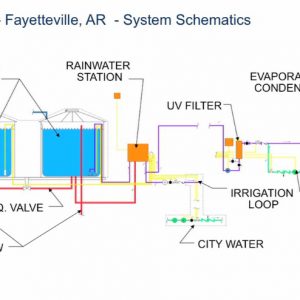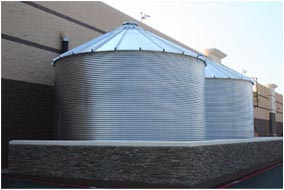 Wal-Mart and Sustainability?… an oxymoron you say. If you look at Wal-Mart’s efforts over the past decade, you would say that these two go perfectly together. If large corporations like Wal-Mart decided to strictly adhere to the triple bottom line accounting, how much impact would we see in our local environment? This is a very broad question to answer, but one thing I do know, you have to start somewhere. Say what you want about Wal-Mart, but they transact a ton of business and if they put their weight behind sustainability measures, it will surely make a huge impact.
Wal-Mart and Sustainability?… an oxymoron you say. If you look at Wal-Mart’s efforts over the past decade, you would say that these two go perfectly together. If large corporations like Wal-Mart decided to strictly adhere to the triple bottom line accounting, how much impact would we see in our local environment? This is a very broad question to answer, but one thing I do know, you have to start somewhere. Say what you want about Wal-Mart, but they transact a ton of business and if they put their weight behind sustainability measures, it will surely make a huge impact.
Walmart’s Rainwater Harvesting Story
Therefore it was great to hear about Wal-Mart implementing rainwater harvesting systems into their stores since these systems will help make a huge water conservation impact.
Wal-Mart’s built an experimental store in McKinney, Texas in 2005. Wal-Mart developed this experimental store in order to test their sustainability initiatives. It interested me greatly since this was the first time I read about a “big box” company that actively designed rainwater harvesting into the project site.
Other than Wal-Mart’s McKinney store, I had never heard about any other rainwater harvesting projects by Wal-Mart.
Until now…
At the Sustainable Operations Summit in June 2012, Don Moseley, Director of Sustainable Facilities for Wal-Mart gave a presentation on Wal-Mart’s water sustainability efforts, including their rainwater harvesting initiatives.
Key Points from the Presentation
- Wal-Mart began its sustainability journey in 2005 under then-CEO Lee Scott.
- Wal-Mart has 8900+ total stores, 100,000 suppliers globally, 2 million Associates, and 200 million customers served each week.
- Wal-Mart has 3 main sustainable goals:
- Be supplied 100% by renewable energy (aspirational goal),
- Create zero waste to landfills in US by 2025,
- Sell products that sustain our resources and environment.
- An initiative like changing stores to LED lighting is a uniform conversion (the savings from and operation of the LED lights will be the same at every store. This is not the case with rainwater harvesting.
- Wal-Mart has 6 stores that incorporate rainwater harvesting into them. While the have about 50 stores that incorporates stormwater collection into ponds, these 6 stores were deliberate corporate decisions to incorporate rainwater and measure its effects.
- Rainwater was mainly stored in ponds or retention/irrigation ponds.
- McKinney, TX store water savings in 2010: 885,896 gallons (all to site irrigation).
- Fayetteville, AR store collects 62% of roof area into two 33,000 gallon aboveground cisterns through siphonic roof drains
- Arden, NC: originally designed with 35,000 gallon underground cistern, but due to infeasibility of supplying the irrigation demand for the development, they changed to collecting the runoff into an existing pond that they made larger. They changed landscape design to reduce water needs.
- In Arden, water is only $1.76/1,000 gallons so by doing the math with the savings, the harvesting of water doesn’t make business sense.
Lessons Learned from Wal-Mart’s Rainwater Harvesting Initiative
Mr. Moseley provided a summary of the lessons learned through Wal-Mart’s rainwater harvesting efforts:
- Reduce overall water and irrigation demand first
- Do the math (in order to make the best decision on system design and size)
- System commissioning is a must
- Set controls and metering expectations early
- Clearly define operation and maintenance requirements
For Wal-Mart, rainwater harvesting has to make business sense. Therefore, in most communities, Wal-Mart would probably not promote rainwater harvesting since the cost of water is so low at this point in time. Bottom line, Wal-Mart is about getting rid of waste and using resources more efficiently, but since they are a public company, these efforts must pay off and provide a return on investment to their shareholders.
Implementation Cost for Future Conservation Gains
Mr. Moseley discussed how the implementation of LED lighting in their stores reduces energy costs especially since the places where the LED lights are used, they are running almost 24 hours a day. He says that these changes provide uniform energy savings across all stores. These types of energy saving retrofits are less intrusive and thus less costly to implement so they will get chosen first. So once this improvement is implemented (the low hanging fruit), the next energy conservation step may require more investment and/or time in order to get a return on the investment.
The main issue about not investing in water conservation technologies like rainwater harvesting and graywater reuse during construction, is that once the water savings become needed for bottom-line issues, it will be much more costly to implement these solutions at a later time.
Changing lights in a freezer case from fluorescent lights to LED lights is easy, after-the-fact. Installing collection piping to convey rainwater from certain drainage points and deliver the rainwater to a water storage device such as a cistern is not so easy, after-the-fact. Implemented during construction, these systems would be easy and less expensive, but at the time of construction, water costs will be low and thus the ROI calculations won’t work out.
So once the low-hanging fruit is picked from the “conservation tree”, where will these corporations go to find the next level of conservation and thus cost savings? By not investing in certain technologies upfront, it could cause the next level of conservation to be delayed even longer since implementation costs after-the-fact will prevent quicker adoption of these technologies.
So do you think Wal-Mart should be doing more on the water conservation front?




